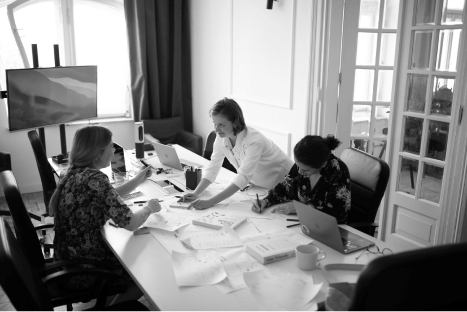
5 exercises to do if you are developing a digital product
Date 08 June 2023
Have an idea for an app, marketplace or streaming service? Get your team together and do a workshop before you start creating it. The results may surprise you! This is a very important stage of the product discovery process.
Clients come to us with projects at very different levels of progress. Sometimes, at the beginning of the journey, before the product discovery process. Sometimes, when they have a prototype but it deviates from their ideas. Still other times, when they have launched a product but it is not generating interest and profits. Although each of these situations is a different phase of product development, the first step in our collaboration is the same: we organise a workshop with the client. During these, we bring out realised and unrealised assumptions, motivations and strategies for action. We gain knowledge that allows us to assess the situation and plan further work.
Workshop planning
We always plan the workshop so that we collect or produce as much material as possible for the next stage of the work. We always establish the purpose of the workshop with the client so that it is clear to the whole team what we want to achieve. And it is the goal that determines the types of exercises we choose for the meeting. We draw from different processes and methods (e.g. Design Thinking, Design Sprint, Lightning Decision Jam, etc.). We never run the same workshop twice. We approach each project individually, depending on the information provided by the client, the product and who we will be working with.
We divide the exercises into those concerning the business, the users and the product itself. Our workshop programme usually includes tasks aimed at each of these aspects. Depending on our needs, we use ready-made exercise templates, so-called 'canvases', or design an individual command path. We take a flexible approach.
By using exercises, the work goes much faster and is definitely more valuable than a simple talk. They also allow us to involve the whole team, who can co-create the project and have a real input into the final product.
Discover the five exercises you should do! If you are working on your own digital product, do the five exercises described below. Keep to the order in which we present them.
1. Personas
Who will use your product? You've probably already defined the audience segments you want to create it for, and you've managed to collect a lot of data on each of them. Great, but now forget for a moment that your customers form groups. Recognise one person in each of them, a representative representative, and characterise them.
Write down on a piece of paper the answers to the questions:
- What is the name of the representative of your chosen customer group? Attach his/her photo - find a sample face on the internet or in a newspaper.
- How old is he/she? Where does he live? What is his/her education and profession?
- What is his marital status? Does he have children?
Then create a short biography of such a person and identify:
- For what purpose will she use the product?
- What does he/she expect from it?
- What problems might she have using the product?
- You can also add information about her hobbies, character traits and create a list of favourite brands.
Repeat the task for each audience segment. During the workshop, divide the group into teams and each develops a persona for a different segment and then presents it to the forum so that all participants have the same level of knowledge. By building personae, the team empathises with the target group. It discovers their needs and motivations. Knowing and understanding them is a prerequisite for creating a profitable digital product. Duration of the exercise - approx. 45 minutes.
2. Sailboat
In this exercise we will look at an organisation that undertakes the building of a digital product. On a piece of paper, draw the outline of a sailboat - it must have a deck, a sail and an anchor.
Next to each of these three elements, now write down respectively:
- on the deck – information about available resources (e.g. technology, human resources),
- on the sails – the trends and phenomena that will drive product development,
- on the anchor – the problems that are distancing you from achieving your goal.
You can also enrich your picture with:
- rocks – here indicate the risks that may arise in the future,
- island – here describe the goal you are aiming for.
When you have completed the task, read through the information you have collected. Consider whether it needs to be tidied up. Remove repetitive data. Tip: Write down each piece of information on a separate sticky note, so that you can sort the information you have collected more easily.
3. Customer Journey Map
Now that you understand your customer's needs and motivations and know your organisation's capabilities and limitations, you can start planning the path of their journey. It has several fixed points:
- first, the customer must become aware of the need that your product satisfies,
- then he looks for a way to satisfy the need,
- if he reaches your product, he will use it,
- perhaps not once, but many times - he will return to your product,
- and if he is satisfied with it - he will probably recommend it to other people.
This is the standard path. You can mark other stages on it, specific to your product. Then, at each stage, write down the problems the customer encounters on red sticky notes. On the yellow ones, describe how your product can solve these problems.
Create one pathway for each persona. This will allow you to compare user and product problems in one place, which you will need to pay attention to in the next stages of your work. Duration of exercise: approx. 60 minutes.
4. How Might We
During the creation of the personas, you wrote down the problems and pain points of the users. Gather this information and turn it together into questions to which you will try to find as many answers as possible. Each question should be noted down on a separate sheet of paper. Exemple:
- Problem identified: The form on the website is too complicated for users.
- Question: How might we simplify the form on the website in a way that users can understand?
Remember not to make the questions too narrow so as not to suggest potential solutions. Do not jot down any additional information on the sheets. Each team then individually writes down as many answers to the question as possible – each answer on a separate sticky note. Do not share ideas, work individually. It should take you about 2 minutes to work on each question.
After this time, everyone sticks a piece of paper under the question with their ideas. If the answer is not clear, a participant briefly explains the proposed solution. Finally, make sure the answers are clear to everyone.
Do not continue with an in-depth discussion on the proposed solutions. Instead, to narrow down the number of ideas, carry out an exercise called Dot Voting. Each participant is given about 3-5 votes (in the online format these can be circles of different colours, while in the face-to-face workshops it is useful to have self-adhesive coloured dots). Within 3 minutes, everyone distributes their votes to the selected ideas. Those that receive the most points move on to the final stage of the workshop.
5. Impact / Effort Matrix
In the last task, we move on to verifying the selected ideas in terms of the importance for the user (Impact) and the cost and effort (Effort) it will take to implement the solution.
Prepare a board and divide it by the X and Y axis into four boxes. The X axis represents importance (Impact) and the Y axis represents cost and effort (Effort). Now place the slips of paper in the boxes with the ideas that received the most votes in the Dot Voting exercise. Only here do you begin to discuss the ideas submitted. It is worth asking additional questions in particular to:
- the technical team, who can assess the idea in terms of feasibility,
- to the sales, marketing and design professionals, who will look at it in terms of the impact on users and the organisation's business goals.
Now look at where you have placed the ideas. If they have been placed in the box ...
- high impact / low effort – implement them first,
- low impact / low effort – consider them as additional functionality, perhaps useful or encouraging the user to use the product,
- high impact / high effort – move them to the next version of the product, depending on the resources available,
- low impact / high effort – let them go.
Finally, summarise the result of the exercise and determine whether it is equally understandable to everyone.
We hope that the suggested exercises will be a good basis for you to start your product discovery process. If you need product strategy agency, we are here to help you. Get in touch, we will talk to you, identify your needs and choose the right tasks.
Insights
View AllLet us inspire you.
- InsighteBOOK: How to build products that make money
![5 exercises to do if you are developing a digital product]()
- Case studyDesign Practice podcast: How do we help build digital products from A to Z?
![5 exercises to do if you are developing a digital product]()
- InsightTalk to the user! How to conduct IDI research
![5 exercises to do if you are developing a digital product]()


